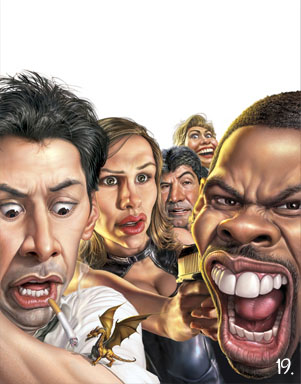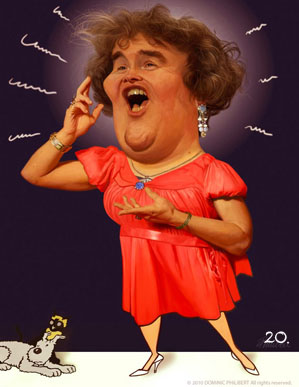Q: Do you think which commercial commissioned work is the most interesting (or the most satisfying) one?
A:
I would say that my favorite commission is the illustrations that I created for the Major League Baseball (MLB) New York for their 2001 All-Star Game. The job consisted in completing five illustrations within three days. With such a short deadline I needed to develop shortcuts and I had to learn quickly how to be efficient in the process of creating commercial works. On another side, I was impressed by their professionalism. They offered me a great number of references and even took the time to write me two letters of appreciation which is rarely seen in the business. I really felt appreciated for my work as an artist.
Q: Will there be any difference between the final works submitted to the clients and the beginning ideas? Are there any examples of this?
A:
Usually the clients already have an idea in mind. They send me a sketch or a photomontage to give me a basic idea of the direction of the work. Afterwards I send them a rough sketch for their approval. Once the sketch is accepted I begin to finalize the work by tightening the features and then I start to paint the final illustration. Occasionally there will be minor corrections, but normally there are no modifications to be made after the sketch approbation. Although, when a customer has no idea of what he wants it can be very difficult to guess what result he is really expecting. In these cases we might be caught in a long struggle of modifications and corrections. A situation you definitely want to avoid…
Q: Many readers wonder how your process of creating a caricature is.
A:
First of all I study the face’s features and make many quick sketches where I compare and explore the different possibilities. From there I keep the most interesting ideas and create from these a last rough sketch. I then redraw this same sketch finalizing the details which bring the likeness of the subject. The final stage is the painting where I correct the last details in order to get the most interesting result while keeping the likeness.
Q: Could you show us some sketches in your creative process?
A:
The creative process relies on the research of reference materials which give me information on the positioning, the lighting and the elements of the composition that I will then have to draw. Once the drawing is completed, I start painting which is basically a matter of thinking in terms of values and mastering the color application techniques.

Q: What is the key point to capture the characters’ characteristics do you think?
A:
You have to observe and make a decision as to what is more obvious and predominant in the face or the body. Look for shapes, line of action, balance, and the weight of the different elements on a person’s anatomy. This process is hard to explain considering that if you had many caricaturists sketching the same subject the result would be very different from one to another. Sketching is the key.
Q: How do you handle the exaggeration extent of a character?
A:
Everything comes from observation. When I begin a caricature I try to keep in mind the impression that I had the first time I saw the person. I also look at many photos and videos in order to capture the subject’s gesture. This gives me the information that I need to exaggerate the expression and the posture. This is how I create a character which is interesting and dynamic.
Q: What is your favorite subject matter of painting?
A:
I would say people. I love playing with faces and hands. I like to give my characters funny expressions. I find it really pleasant to distort a face while keeping it very realistic. Most of the time, just a subtle change in the expression or hand’s positioning can make a drawing look way more appealing.
Q: Which artists have great impact on your creativity?
A:
Definitely Mark Fredrickson. Because he managed to innovate in the 90' with a unique and particularly dynamic style based on fisheye distortions and a realistic airbrush rendering. His illustrations are astonishingly original, extremely well composed and are executed by hand in an incredibly short amount of time. He now works on computer, and his work continues to impress me.
 |
※Mark Fredrickso
For more work:
http://www.rappart.com/index.php?section=portfolio&portnum=131
|
Q: Compare the traditional painting tools, such as pencils, watercolor, with modern digital painting tools, such as Photoshop and other painting software, how do you think the difference between them? Which way do you prefer?
A:
I think that computer is the ideal tool for commercial work. It gives you the possibility to execute the work more rapidly, makes the corrections easier and simplifies the sending. However, the computer generates only prints, contrary to traditional mediums which works shall always have a place in art galleries and exhibitions. I think mastering both is essential as both have their reason of being depending on their purpose.
Q: Your works are so excellent, and so many people like them. But we wonder whether you encountered people who don’t like them and how did you deal with it?
A:
Thank you for your kind words. Of course it has happened to me, and I would say that it should happen even more often (laughs). Because criticism has positive effects on me, it pushes me to work harder which result in improving my skills and getting better at doing my craft. I believe that it is important to keep a critical eye upon our work, we do not have all the truth or answers. Everyone has the right to their own taste or opinions and it is important to not feel personally attacked when our work is questioned.
Q: In your country, what’s the status of caricature artists? Will it be limited in some ways?
A:
In Canada we have the chance to have a great liberty of expression. Artists can express themselves quite freely in their creations, critiques and opinions. I would say that any measure of censure is from within themselves in their fears and limitations, avoiding negative repercussions. Here as anywhere else there are subjects that remain taboo and/or controversial. So it is also mainly simply a question of respecting others.
Q: Could you introduce your current new project?
A:
One of the last projects that I did was a caricature of Susan Boyle. This commission was done for Le Samedi magazine. The concept was to mix the singer Susan Boyle with the Castafiore. I had fun painting the Castafiore (2d) then transformed it into a realistic Susan Boyle (3d effect).

Q: What’s your suggestion for those who want to engage in caricature? How to become a successful caricature artist?
A:
There are no success stories without putting a lot of effort and working really really hard and having discipline. I believe in hard work and dedication. That is the “secret”. Also be yourself, don't be afraid of being different or being judged. And never forget: practice makes perfect. So load your brush and paint!
Q: Please write a sentence with your signature for China’s fans!